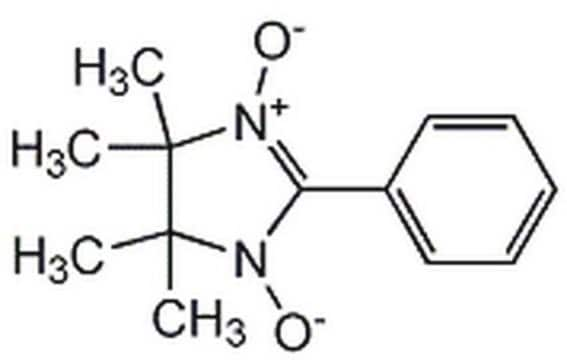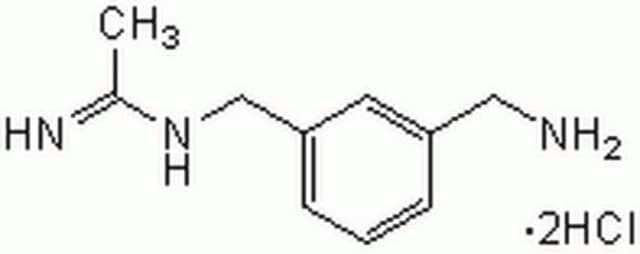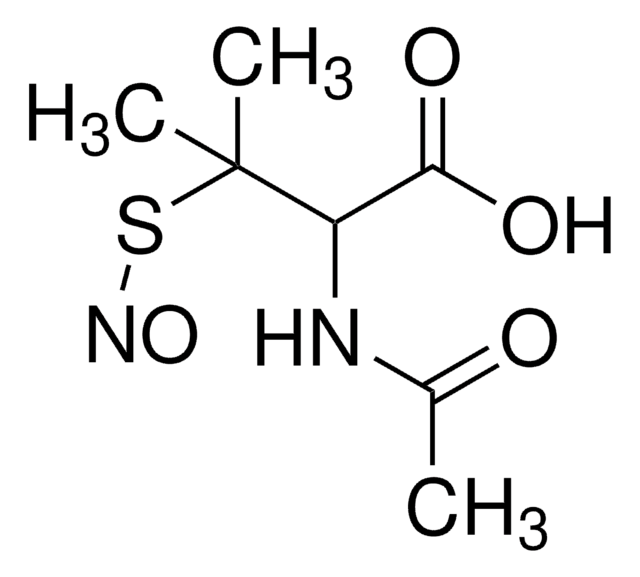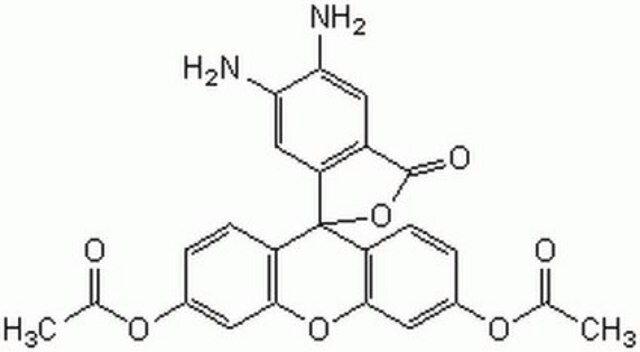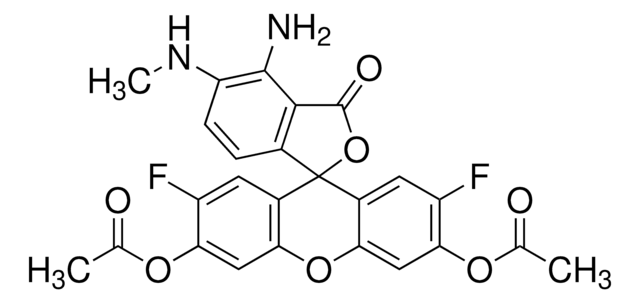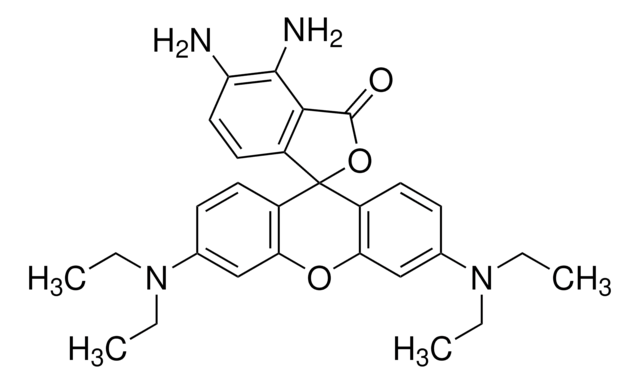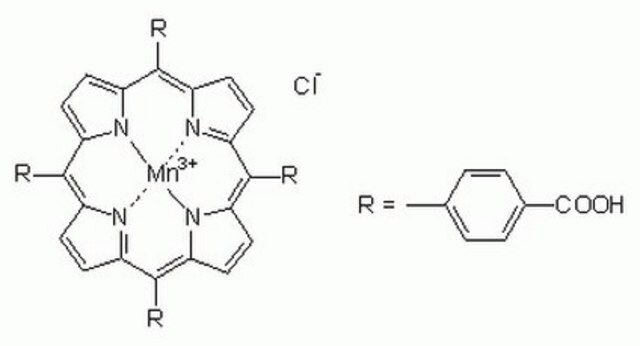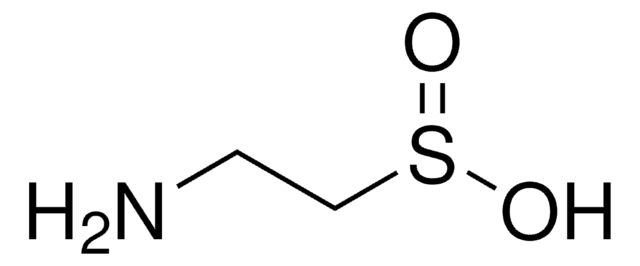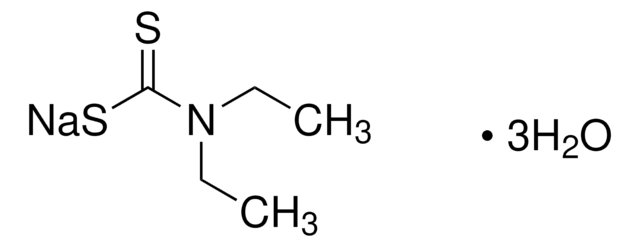C221
Carboxy-PTIO potassium salt
동의어(들):
2-(4-Carboxyphenyl)-4,4,5,5-tetramethylimidazoline-1-oxyl-3-oxide potassium salt, 2-(4-Carboxyphenyl)-4,5-dihydro-4,4,5,5-tetramethyl-1H-imidazol-1-yloxy-3-oxide potassium salt
로그인조직 및 계약 가격 보기
모든 사진(1)
About This Item
실험식(Hill 표기법):
C14H16KN2O4
CAS Number:
Molecular Weight:
315.39
MDL number:
UNSPSC 코드:
12352200
PubChem Substance ID:
NACRES:
NA.32
추천 제품
생물학적 소스
synthetic (organic)
Quality Level
분석
≥98% (TLC)
양식
powder
mp
>270 °C
solubility
H2O: 100 mg/mL
DMSO: soluble (lit.)(lit.)
methanol: soluble (lit.)(lit.)
저장 온도
2-8°C
SMILES string
[K+].CC1(C)N([O])C(c2ccc(cc2)C([O-])=O)=[N+]([O-])C1(C)C
InChI
1S/C14H17N2O4.K/c1-13(2)14(3,4)16(20)11(15(13)19)9-5-7-10(8-6-9)12(17)18;/h5-8H,1-4H3,(H,17,18);/q;+1/p-1
InChI key
VYEUQMVIGXFZQU-UHFFFAOYSA-M
유사한 제품을 찾으십니까? 방문 제품 비교 안내
일반 설명
2-(4-Carboxyphenyl)-4,4,5,5-tetramethylimidazoline-1-oxyl-3-oxide (carboxy-PTIO) is mainly considered as a scavenger of nitric oxide (NO).
애플리케이션
Carboxy-PTIO potassium salt has been used to check the generation of hydroxyl radicals or nitric in reaction mixtures to examine the generation of nitric oxide in reaction mixture. It has also been added to neurons to analyse its effect on glucose/oxygen/serum deprivation (GOSD) condition(4)
생화학적/생리학적 작용
Carboxy-PTIO can make a quick reaction with nitric oxide (NO) to produce nitrogen dioxide (NO2). It can be used to prevent hypotension and endotoxic shock, stimulated by lipopolysaccharide in- vivo. Carboxy-PTIO can also block in vitro vascular relaxation, stimulated by NO.
Reacts with nitric oxide to form carboxy-PTI derivatives which in turn inhibits nitric oxide synthase.
Storage Class Code
11 - Combustible Solids
WGK
WGK 3
Flash Point (°F)
Not applicable
Flash Point (°C)
Not applicable
개인 보호 장비
Eyeshields, Gloves, type N95 (US)
이미 열람한 고객
Raymond N Allan et al.
Nitric oxide : biology and chemistry, 65, 43-49 (2017-02-27)
Bacterial biofilms show high tolerance towards antibiotics and are a significant problem in clinical settings where they are a primary cause of chronic infections. Novel therapeutic strategies are needed to improve anti-biofilm efficacy and support reduction in antibiotic use. Treatment
Xinyi Zhu et al.
Applied and environmental microbiology, 85(3) (2018-11-28)
While both iron and nitric oxide (NO) are redox-active environmental signals shown to regulate biofilm development, their interaction and roles in regulating biofilms have not been fully elucidated. In this study, exposure of Pseudomonas aeruginosa biofilms to exogenous NO inhibited
Nitric oxide scavenger carboxy-PTIO potentiates the inhibition of dopamine uptake by nitric oxide donors
Cao B J and Reith M EA
European Journal of Pharmacology, 448(1), 27-30 (2002)
Interference of carboxy-PTIO with nitric oxide-and peroxynitrite-mediated reactions
Pfeiffer S, et al.
Free Radical Biology & Medicine, 22(5), 787-794 (1997)
M Yoshida et al.
Biochemical and biophysical research communications, 202(2), 923-930 (1994-07-29)
We recently found a new class of nitric oxide (NO) antidote, i.e., 2-phenyl-4,4,5,5,-tetramethylimidazoline-1-oxyl-3-oxide derivatives (PTIOs). It has a potent inhibitory action against endothelium-derived relaxing factor. Here, we report the effect of a water-soluble carboxy derivative of PTIO (carboxy-PTIO) on endotoxin
자사의 과학자팀은 생명 과학, 재료 과학, 화학 합성, 크로마토그래피, 분석 및 기타 많은 영역을 포함한 모든 과학 분야에 경험이 있습니다..
고객지원팀으로 연락바랍니다.
